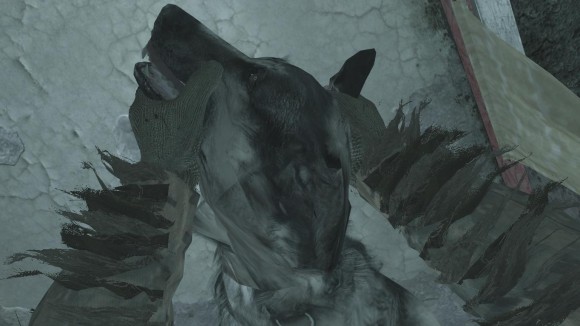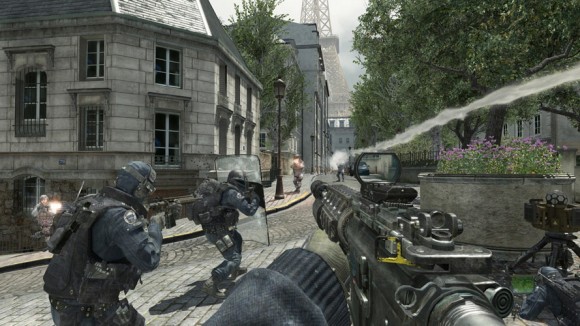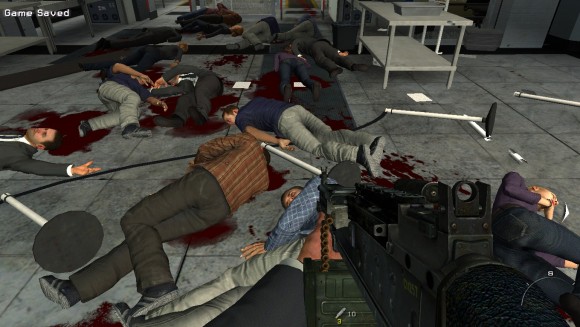Unless you live under a rock, you are probably familiar with the popularity of video games in modern day society. However, the video games you are probably familiar with are likely very different from the kind older folks grew up playing. One big difference is the level of mature content present on-screen. In recent years, numerous games have attracted quite a lot of controversy over their presentation of violence, sexual situations, substance abuse, and other such sensitive topics. Arguably the one that media rambles most about is violence.
Violence has generally always been a part of video games, in one form or another. In one of the earliest video games, Donkey Kong (you can play it here: http://www.freekong.org/), the protagonist you control can be killed by flames, heavy objects bouncing around the screen, a fall to his death, failure to complete the game on time, or the eponymous giant gorilla Donkey Kong.
Donkey Kong (1981)
While death is not necessary to show that one has failed in a video game, it certainly helps to establish the concept well and easily and so it was and generally still is the most readily chosen option for representing failure in a video game. However, due to limited technology at the time, early depictions of death were cartoonish and simple and did not raise any fuss.
Controversy over video game violence first started with the 1976 game Death Race.
Death Race (1976)
In this game, you run over innocent pedestrians to score points. Although the graphics are too simple to be realistic at all (pedestrians are merely rendered as stick figures), the very concept of running over innocent pedestrians in a video game unsurprisingly provoked the more sensitive in society. In 1982, the game Texas Chainsaw Massacre allowed players to kill innocent civilians, this time with slightly improved but still simplistic graphics and no blood, but unlike Death Race, no real controversy was raised.
Texas Chainsaw Massacre (1982)
It appeared that just six years of games and a link to a popular film allowed Texas Chainsaw Massacre to get away with killing innocent civilians.
In 1986, the presence of actual blood and gore first appeared and (not surprisingly) attracted a lot of attention. The game Chiller provided players with an utter and very bloody torture simulator, and many arcades refused to support the game.
Chiller (1986)
By 1987, the game Death Wish III failed to attract any attention for allowing players to use a rocket launcher to turn both enemies and prostitutes into bloody piles, as violent shooter games with action movie connections or at the least the spirit of an action movie had already become the norm.
Death Wish III (1987)
The 1987 game Barbarian: The Ultimate Warrior did raise attention though for depicting brutal combat and decapitation.
Barbarian: The Ultimate Warrior (1987)
Keep in mind the video games at this time were still viewed as children’s playthings.
By 1988, new technology allowed for more realistic depiction of violence. The 32-bit (which was quite revolutionary at the time) video game Narc allowed players to blow human enemies into bloody bits, but the attack dogs in the game only shrink down and run away when shot.
Narc (1988)
In many recent Call of Duty games, players kill dogs in realistic and bloody manner, but yet no one seems to bat an eye.
Breaking a dog’s neck in Call of Duty 4: Modern Warfare (2007)
This would not be the first time that society is seen having relatively strange and ironic standards for what is considered decent.
By 1992, CD-ROMs were all the rage. The 1992 game Night Trap featured live action video and was not particularly gory but led to cries for censorship for its realistic depiction of violence against women.
Night Trap (1992)
Also in 1992, the game Mortal Kombat was released.
Mortal Kombat (1992)
The depiction of bloody fighting and brutal killing moves often featuring decapitation or dismemberment led to lawsuits attempting to censor or strictly regulate the game. Nevertheless, the series has continued to be popular and released its latest game in 2011, which was banned in Australia, Germany, and South Korea for its violence. Mortal Kombat’s controversy led to the establishment of the Entertainment Software Rating Board (ESRB), who now put a rating on all games. Since some of the ratings restrict purchase of games to those 17 or 18 and over, this ended the view that video games were merely children’s playthings, and now games could be free to be ever more violent without the worry of attracting attention.
In one of the more notable instances of video game controversy, the 1993 first person shooter (FPS) game Doom attracted a lot of attention for supposedly causing violent behavior in and serving as a “training ground” for Eric Harris and Dylan Klebold, the murderers behind the 1999 Columbine massacre.
Doom (1993)
For a time, people were scared of FPSs and feared that they may be turning kids into violent killers. In 2011, similar fears were raised after Anders Behring Breivik went on a terrorism rampage in Norway that left 77 dead. Breivik supposedly used the game Call of Duty: Modern Warfare 2 as training for his acts of terrorism, and Norway subsequently banned 2011’s two most popular FPS games Battlefield 3 and Call of Duty: Modern Warfare 3 from even being released in the country.
Call of Duty: Modern Warfare 2 (2009)
Battlefield 3 (2011)
Call of Duty: Modern Warfare 3 (2011)
After 2012’s Sandy Hook Elementary School shooting, the National Rifle Association (NRA) tried to blame video games for turning gamers into violent killers once again. This time though, few bought this claim as being true, as the proliferation of FPS games in recent years (the 2010 game Call of Duty: Black Ops was at one point in one out of every eight American homes) has destroyed any sense of credibility in the idea that they are corrupting gamers’ minds.
Call of Duty: Black Ops (2010)
Returning to the 1990s, the 1995 game Phantasmagoria featured bloody depictions of live actors meeting bloody ends.
Phantasmagoria (1995)
The game was banned in Australia, and many retailers refused to sell it. In 1997, the next major controversy surrounding video games arrived in the form of Carmageddon, which allowed players to run over pedestrians to score points again, this time in far more realistic (relatively for the 1990s) and bloody detail.
Carmageddon (1997)
The outcry led to the game being altered to running over green blooded zombies in the UK and robots in Germany. The troublesome nature of killing civilians in a video game transcends the limits of time. The Grand Theft Auto series has attracted plenty of attention since its 1997 inception for allowing players to casually commit random and reckless acts of violence such as killing prostitutes and taking their money afterward, as a common joke/meme goes.
Grand Theft Auto IV (2008)
The next millennium brought with it new ways to raise ire. The 2002 game Postal 2 allowed players to control a psychopath killing civilians and even allowed the player to urinate on the dead bodies.
Postal 2 (2002)
The 2003 game Manhunt created arguable the most controversy in recent years by allowing players to play as a death row inmate forced to creatively kill for a snuff film (a film featuring actual people dying), leading to bans in multiple countries.
Manhunt (2003)
Since Manhunt, common bloody violence in video games has become more accepted and no longer causes the controversy it once did. In 2005 though, Resident Evil 4 did raise some attention for depicting the player dying by decapitation via chainsaw.
Resident Evil 4 (2005)
Finally, the most recent major controversy surrounding video game violence arose in 2009, with the “No Russian” mission in Call of Duty: Modern Warfare 2 attracting a lot of outrage for allowing players to massacre a whole airport full of innocent civilians.
“No Russian” from Call of Duty: Modern Warfare 2 (2009)
Some biased sources even falsely accused the game of rewarding players with points for massacring the civilians. Ironically, the game never even tells players to kill the civilians. In the mission, the player takes the role of an undercover agent spying from within a terrorist organization. The other terrorists alongside the player happily and liberally massacre civilians, but the player him/herself is never actually told to do so.
Earlier this year, the game Call of Duty: Ghosts was discovered to have files coding for “weed camo,” which would allow the player to put images of cannabis leaves all over their gun.
“Weed Camo” from Call of Duty: Ghosts (2013)
This was likely left out of the game to avoid raising controversy. This is rather strange and ironic. The game rewards players for shooting people in the head; yet controversy is over pictures of cannabis being put on a gun. This shows how far we have come in terms of accepting depictions of violence in video games. Gone are the days where running over stick figure civilians caused concern, and today’s video games usually feature liberal displays of blood and brutality without concern for negative public reaction. Sure, every once in a while, controversy will be raised, but if history has taught us anything, it is that anything considered controversial now will be a common part of popular culture within a few years or decades.
Sources:
http://en.wikipedia.org/wiki/Donkey_Kong_(video_game)
http://en.wikipedia.org/wiki/Mortal_Kombat#Video_games
http://en.wikipedia.org/wiki/Columbine_High_School_massacre#Video_games
http://en.wikipedia.org/wiki/2011_Norway_attacks
http://en.wikipedia.org/wiki/Grand_Theft_Auto_(series)
*Credit for the title goes to Stuart Brown (2014)




























